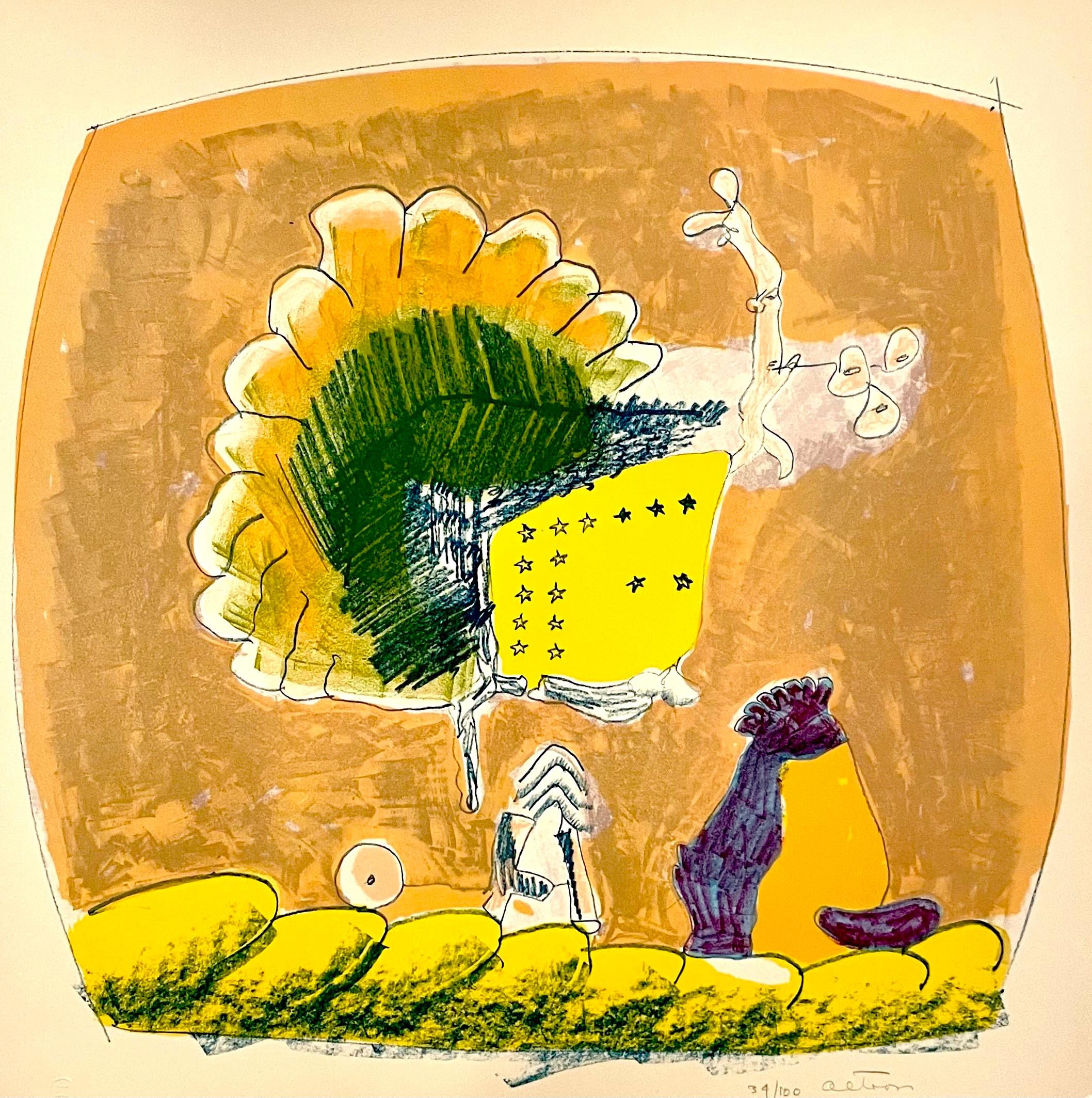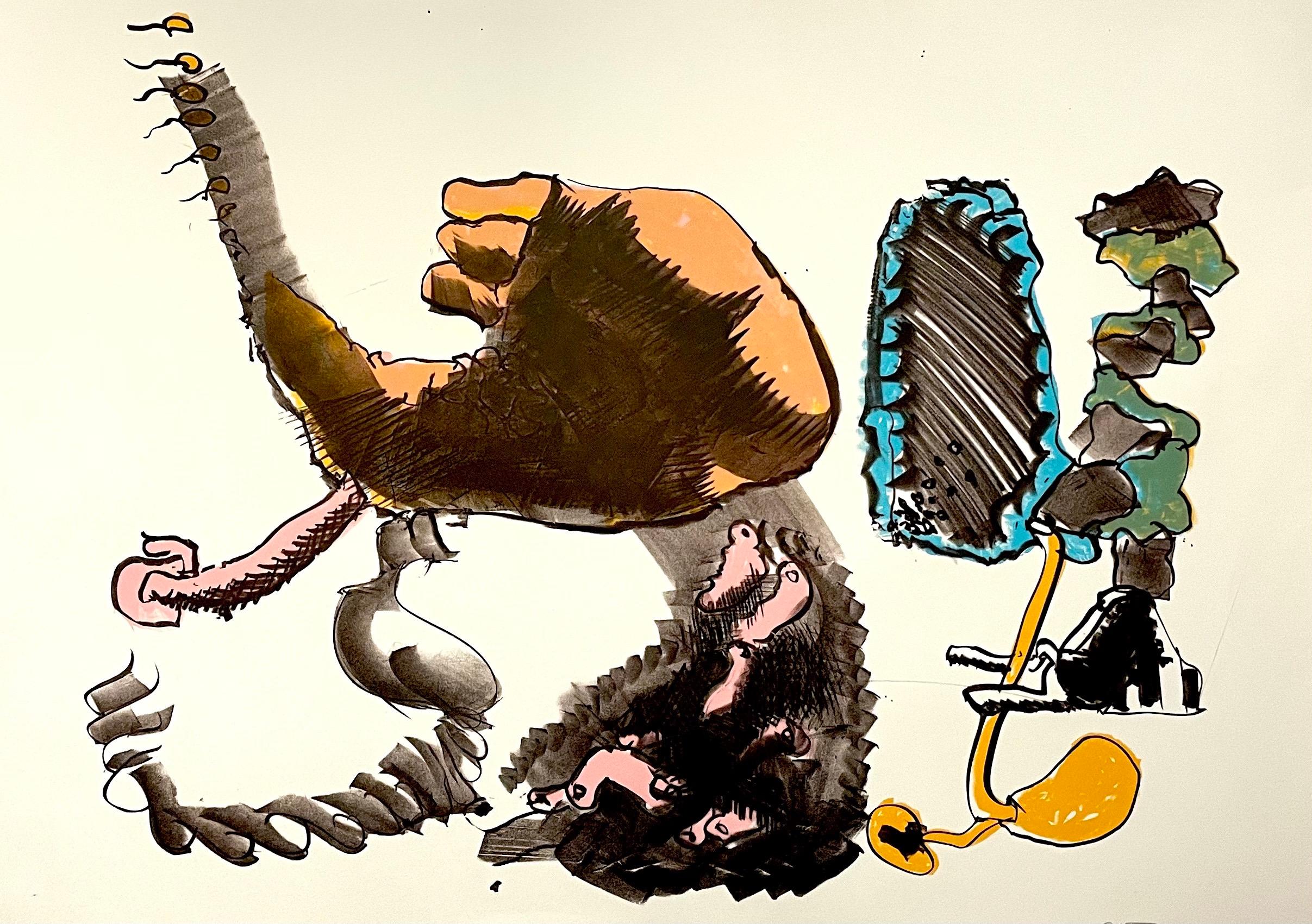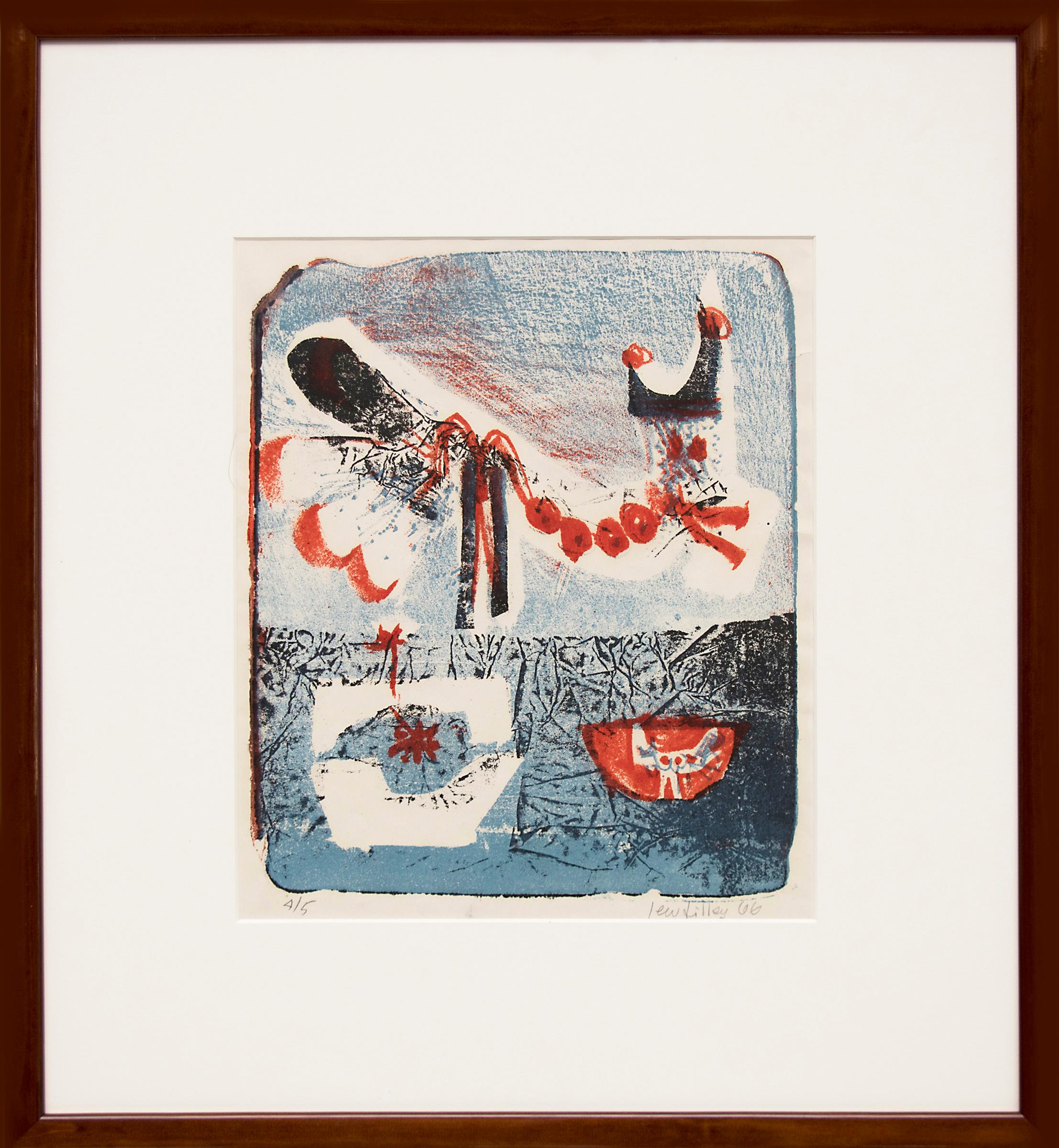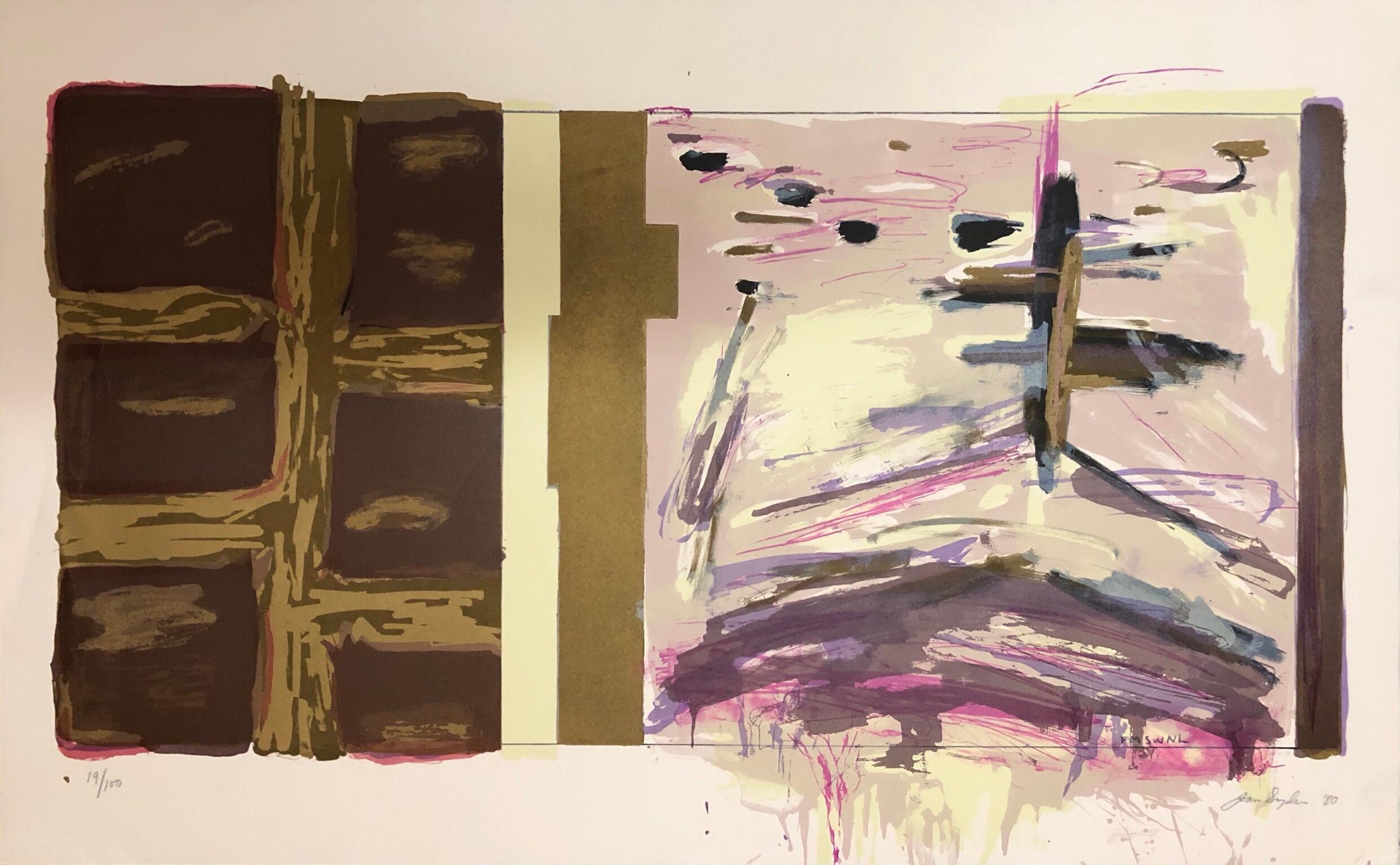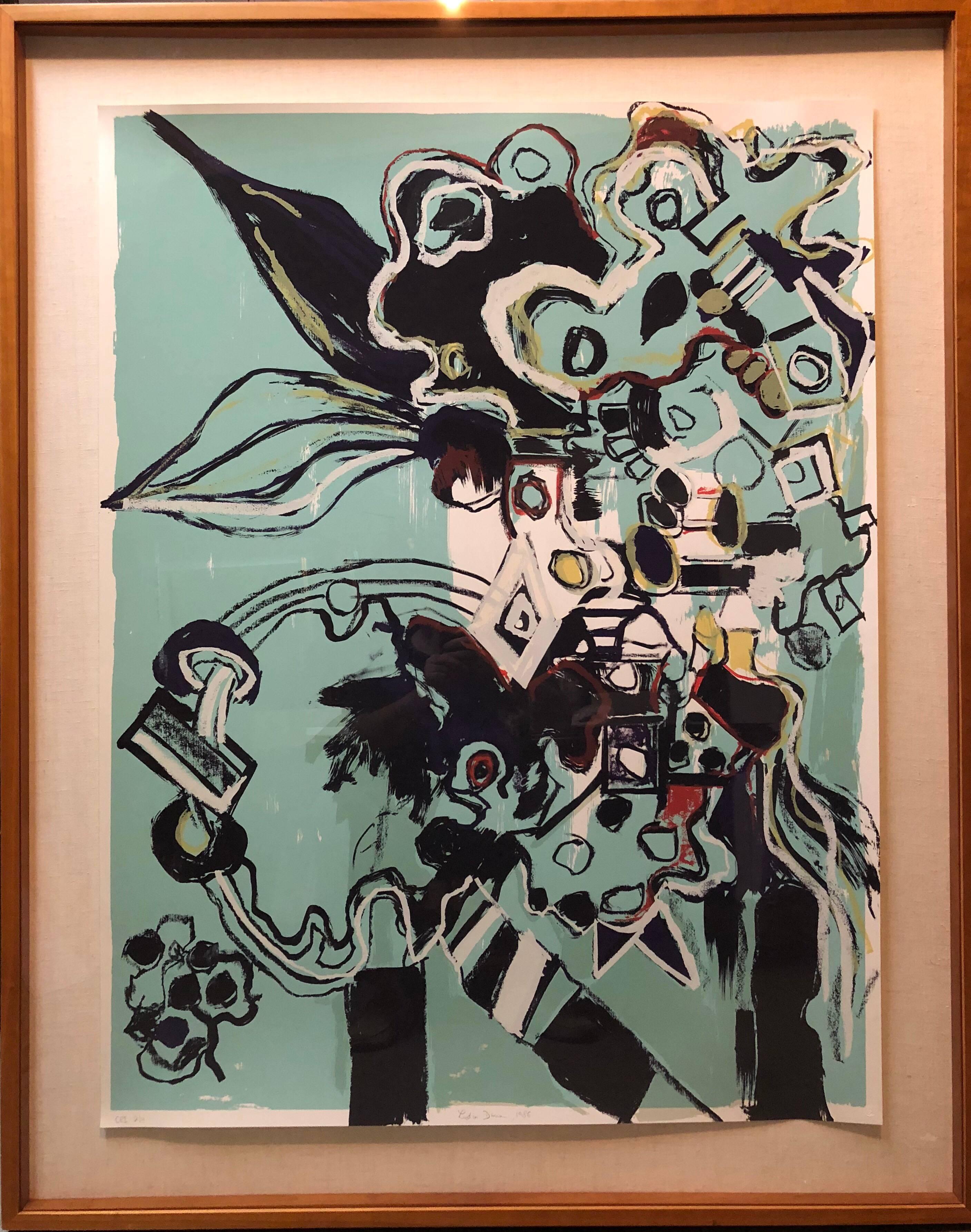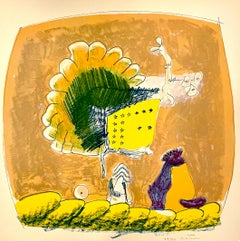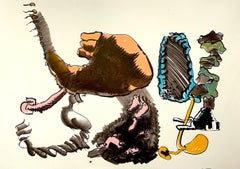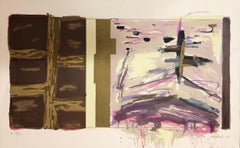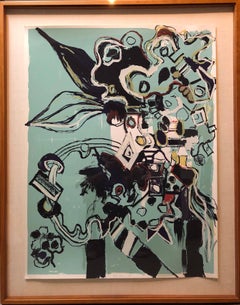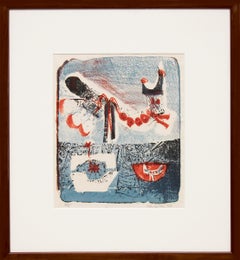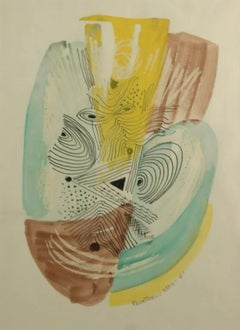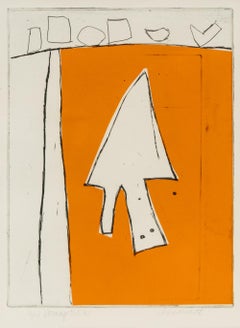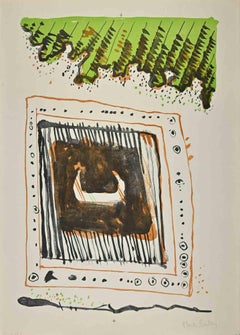Items Similar to 1960's California Pop Art Abstract Expressionist LA Lithograph "About Women"
Want more images or videos?
Request additional images or videos from the seller
1 of 13
John Altoon1960's California Pop Art Abstract Expressionist LA Lithograph "About Women"1965-1966
1965-1966
$1,400
£1,090.87
€1,237.56
CA$2,012.11
A$2,215.53
CHF 1,148.85
MX$26,237.99
NOK 14,583.92
SEK 13,630.32
DKK 9,243.11
About the Item
John Altoon (American, 1925-1969)
From the 'About Women' Series.
Color lithograph
1965/66,
Hand signed and editioned in pencil with the chop mark of Gemini G.E.L. publishers
John Altoon (1925 - 1969), an American artist, was born in Los Angeles to immigrant Armenian parents. From 1947–1949 he attended the Otis Art Institute, from 1947 to 1950 he also attended the Art Center College of Design in Los Angeles, and in 1950 the Chouinard Art Institute. Altoon was a prominent figure in the LA art scene in the 1950s and 1960s. Exhibitions of his work have been held at the Museum of Contemporary Art San Diego, Whitney Museum of American Art, New York, Corcoran Gallery, Washington D.C, Fine Arts Museums of San Francisco, The Baxter Museum, Pasadena, and The Los Angeles County Museum of Art (LACMA).
Altoon's work was influenced by the Abstract Expressionism Movement although he is best known for his figurative drawings of the 1960s, with as Leah Ollman describes "a vocabulary of vaguely figurative, botanical and biological forms that he pursued until his death." He was part of the "Ferus group" of artists so called for their association to the Ferus Gallery that operated in Los Angeles in 1957–1966. Some of the other artists included in this group are Edward Kienholz, Larry Bell, Robert Irwin, Billy Al Bengston. He was featured in the Cool School documentary, a film about Altoon and other Ferus Gallery artists such as Walter Hopps and Ed Kienholz, Craig Kauffman, Wallace Berman, Ed Moses, John Altoon, Ed Ruscha and Robert Irwin. many Ferus artists say John was the most fun and friendliest of all, every where everyone liked him. He could charm anyone. Altoon, during his Ferus Gallery years, did the Ocean Park series which depicted an area around Venice and Santa Monica beach towns in California. The series was 18 paintings as well some works he did on paper. It had the direct from brain to hand & brush approach he was known for: the abstracting of nature on his canvas by pushing through a spontaneous approach, freehand biomorphic in design giving us his surrealist interpretation as a direct rendering of the coastal surroundings.
Leah Ollman describes his life a 1999 article in Art in America, "With his outsized personality and reckless intensity, John Altoon loomed large in the L.A. art scene of the '50s and '60s". In the course of his brief artistic career, John Altoon made an explosive impression on the Los Angeles art community of the 1950s and ’60s, in part because of his volatile personality. He produced drawings, paintings, and prints of overt satires, surrealist personal nightmares, and improbable sexual situations. In fact, Altoon frequently used his dreams and fantasies as subjects, influenced by his encounter with Surrealism in his travels through Europe. His renderings had a characteristically misty or ghostly quality, which Altoon achieved by using an airbrush to apply color. Altoon was diagnosed as schizophrenic in his late 30s and suffered bouts of depression and paranoia. From 1962 to 1963 he produced the pop art Advertising Parodies series and large-scale pastels that explored the figure as represented in the media and pop culture, pulling imagery and text from commercial advertisements. In 1965 he worked at the Tamarind Lithography Workshop, which taught a generation of American master printers. Altoon continued to draw throughout his career, creating his Animal and Cowboys and Indians series from 1966 to 1968, in which the comical and sexually explicit implications that abound in his early work "gave way to softer, biomorphic forms that were vaguely sexual and highly fanciful."Irving Blum, partner in the Ferus Gallery, recalls: "If the gallery was closest in spirit to a single person, that person was John Altoon--dearly loved, defiant, romantic, highly ambitious--and slightly mad." Altoon's struggle with mental illness, his big, dark, robust personality and his early death from a heart attack at 44 have, even more than his art itself, come to define his legacy."
- Creator:John Altoon (1925 - 1969)
- Creation Year:1965-1966
- Dimensions:Height: 19 in (48.26 cm)Width: 38 in (96.52 cm)
- Medium:
- Movement & Style:
- Period:
- Condition:good. minor wear. never been framed.
- Gallery Location:Surfside, FL
- Reference Number:1stDibs: LU38215971202
John Altoon (1925-1969) was an artist and commercial illustrator known for loose drawings of botanicals and natural form. His work crosses a hybrid between abstract and figurative, influenced by Abstract Impressionism. Altoon used color and line movement to connect sociopolitical messages with the viewer’s eye. A prominent member of the Ferus Gallery’s group of artists and Wallace Berman’s Semina circle, Altoon was influenced of artists like Pablo Picasso in creating raw, satirical pieces of work. Born in Los Angeles, John Altoon attended the Otis Art Institute, the Art Center College of Design, and the Chouinard Art Institute. His work has been exhibited at the Museum of Contemporary Art San Diego, the Whitney Museum of American Art, New York, and Fine Arts Museums of San Francisco.
About the Seller
4.9
Platinum Seller
Premium sellers with a 4.7+ rating and 24-hour response times
Established in 1995
1stDibs seller since 2014
1,836 sales on 1stDibs
Typical response time: 1 hour
- ShippingRetrieving quote...Shipping from: Surfside, FL
- Return Policy
More From This Seller
View AllCalifornia Pop Art Abstract Expressionist LA Lithograph John Altoon About Women
Located in Surfside, FL
Hand signed and numbered
About Women
Printed by Kenneth E. Tyler; published by Gemini G.E.L.
John Altoon (1925 - 1969), an American artist, was born in Los Angeles to immigrant Arm...
Category
1960s Pop Art Abstract Prints
Materials
Lithograph
Large 1960's California Pop Art Abstract Expressionist LA Lithograph John Altoon
Located in Surfside, FL
John Altoon (1925-1969)
UNTITLED, 1966, color lithograph, hand signed in pencil and inscribed trail proof II, sheet 29 ¾ x 41 ¼, printed by Gemini G.E.L., with their blind stamp low...
Category
1960s Abstract Expressionist Abstract Prints
Materials
Lithograph
Large Abstract Expressionist Feminist Lithograph Incorporating Text ''FMSWNL''
By Joan Snyder
Located in Surfside, FL
''FMSWNL'' from the limited edition of 100. Pencil hand signed and dated.
Joan Snyder, (born April 16, 1940), is an American painter from New York. She is a MacArthur Fellow, a Gu...
Category
1980s Abstract Expressionist Abstract Prints
Materials
Lithograph
Large Format Modernist Abstract Lithograph Silkscreen Print Woman Artist
By Lydia Dona
Located in Surfside, FL
1982-84 Hunter College, New York (M.F.A.)
1978-80 School of Visual Arts, New York
1973-77 Bezalel Academy of Art, Jerusalem (B.F.A.)
American, born in Romania
Lives and works in New York City
Solo Exhibitions
2008 Michael Steinberg Fine Art, New York
2006 Galeria Joan Prats, Barcelona
2005 Karpio + Facchini Gallery, Miami
Jacob Karpio Galeria, San Jose (Costa Rica)
2004 Michael Steinberg Fine Art, New York
2001 Marella Arte Contemporanea, Milan
2000 Von Lintel & Nusser, New York
Galerie Von Lintel & Nusser, Munich
1998 Galerie Thomas von Lintel, Munich
1997 Galerie des Archives, Paris
1995 Galerie Samuel Lallouz, Montreal
L.A. Louver, Los Angeles
1994 Marc Jancou Gallery, London
Galerie des Archives, Paris
1993 Galerie Barbara Farber, Amsterdam
Real Art Ways, Hartford (Connecticut)
1992 Tom Cugliani Gallery, New York
Galerie Marc Jancou, Zurich
Galerie des Archives, Paris
1989 Tom Cugliani Gallery, New York
Galerie Barbara Farber, Amsterdam
Studied at bezalel from 1973 to 1977. And it was a very fascinating time because it was a highly conceptually based school. Very much influenced by Joseph Beuys, and European Conceptualism, I didn’t really like the atmosphere there that much, because it was dominated by male painters like Jörg Immendorf, Marcus Lupertz, and a few others. then came to New York to study at SVA for two years. New York in 1978 was exciting. I was very lucky to be in a class that was full of very bubbly and very energetic artists like Keith Haring, Kenny Scharf, Tim Rollins, Moira Dryer, Frank Holliday, and Tom Cugliani (who later became one of my dealers).The eighties were dominated largely by Neo-Expressionist paintings. There were Germans, such as Baselitz, Kiefer, Richter, Penck, and the Italians, Clemente, Chia, Cucchi, Palladino as well as Schnabel, Fischl, Basquiat, Salle, and many others, but all of their paintings were figuratively based. But below the popular consent, there was a group of painters who were working more in the vein of what Stephen Westfall referred to as “Neo-Surrealism,” including George Condo, Jeffrey Wasserman, Kenneth Scharf, David Humphrey. However, I felt that Carroll Dunham and you were the only two painters who seemed to be less interested in the kind of narrative, lyrical, or let’s say, stationary composition. He belongs to the generation of Terry Winters, Elizabeth Murray, David Reed and Jonathan Lasker but in some strange way, if we’re looking back to the mid-eighties, we have to include New Image painters like Susan Rothenberg, Neil Jenney, and Robert Moskowitz who were working in between the figure and abstraction with a kind of condensation and compression, in relationship, lets say, to cartoon imagery. There are artists like Jeff Koons, or even Damien Hirst who took the Duchampian aspect and brought it into the continuity of his readymade. But for me, I see no difference between the crack in “Large Glass” and the drips in Jackson Pollock’s paintings. There was something that I felt in my own equation of the continuity between Paul Klee, Duchamp, Picabia, and, oddly enough, Clyfford Still.
What essentially is important is how different artists carry on a dialogue among themselves so that they can all keep their work vital. Whether from the abstract paintings of Richmond Burton, Fabian Marcaccio extending the borders of his paintings on to the wall, or Cady Noland’s early scattered installation, my own pre-occupation with machinery, urban environment, and the Duchampian models has always materialized in relationship to other forms of art making.
Selected Group Exhibitions:
2014 Drawing on Difference: An Ambition by Saul Ostrow and Lidija
Slavkovic, Studio Vendome Gallery, New York.
2013 Drawing on Habit: An Ambition by Saul Ostrow and Lidija Slavkovic,
South Carlton Beach and The Betsy-South Beach Exhibition Programs,
Art Basel, Miami Beach.
2013 Imprinted Pictures: Lydia Dona...
Category
1980s Abstract Expressionist Abstract Prints
Materials
Lithograph, Screen
Pietro Consagra Italian Mod Abstract Expressionist Forma Brutalist Lithograph
By Pietro Consagra
Located in Surfside, FL
Pietro Consagra (Italian, 1920-2005).
Hand signed in pencil and numbered limited edition color lithograph on Magnani paper.
Embossed stamp with limited edition numbers in pencil to lower left, and having artist pencil signature to lower right.
(from a limited edition of 80 with 15 artist's proofs)
Published by Stamperia 2RC, Rome Italy and Marlborough Gallery, Rome, Italy.
Abstract Modernist work in colors, produced in the style of the Forma art movement of Postwar Italy, of which the artist was a prominent member.
Pietro Consagra (1920 – 2005) was an Italian Post war artist working in painting, printmaking and sculpture. In 1947 he was among the founding members of the Forma 1 group of artists, proponents of structured abstraction.
Consagra was born on 6 October 1920 in Mazara del Vallo, in the province of Trapani in south-western Sicily, to Luigi Consagra and Maria Lentini. From 1931 he enrolled in a trade school for sailors, studying first to become a mechanic, and later to become a captain. In 1938 he moved to Palermo, where he enrolled in the liceo artistico; despite an attack of tuberculosis, he graduated in 1941, and in the same year signed up at the Accademia di Belle Arti, where he studied sculpture under Archimede Campini. After the Invasion of Sicily and the Allied occupation of Palermo in 1943, Consagra found work as a caricaturist for the American Red Cross club of the city; he also joined the Italian Communist Party. Early in 1944, armed with a letter of introduction from an American officer, he travelled to Rome. There he came into contact with the Sicilian artist Concetto Maugeri, and through him with Renato Guttuso, who was also Sicilian and who introduced him to the intellectual life of the city and to other postwar artists such as Leoncillo Leonardi, Mario Mafai and Giulio Turcato. Consagra signed up at the Accademia di Belle Arti di Roma in September 1944 and studied sculpture there under Michele Guerrisi, but left before completing his diploma.
In 1947, with Carla Accardi, Ugo Attardi, Piero Dorazio, Mino Guerrini, Achille Perilli, Antonio Sanfilippo and Giulio Turcato, Consagra started the artist's group Forma 1, which advocated both Marxism and structured abstraction.
Steadily Consagra's work began to find an audience. Working primarily in metal, and later in marble and wood, his thin, roughly carved reliefs, began to be collected by Peggy Guggenheim and other important patrons of the arts. He showed at the Venice Biennale eleven times between 1950 and 1993, and in 1960 won the sculpture prize at the exhibition. During the 1960s he was associated with the Continuità group, an offshoot of Forma I, and in 1967 taught at the School of Arts in Minneapolis. Large commissions allowed him to begin working on a more monumental scale, and works of his were installed in the courtyard of the Foreign Ministry in Rome and in the European Parliament, Strasbourg. His work is found in the collections of The Tate Gallery, London, in Museo Cantonale d'Arte of Lugano and the Museum of Modern Art, Paris, and the National Gallery of Art in Washington, D.C..
Consagra returned to Sicily where he sculpted a number of significant works during the 1980s. With Senator Ludovico Corrao, he helped created an open-air museum in the new town of Gibellina, after the older town had been destroyed in the earthquake of 1968. Consagra designed the gates to the town's entrance, the building named "Meeting" and the gates to the cemetery, where he was later buried.
In 1952 Consagra published La necessità della scultura ("the need for sculpture"), a response to the essay La scultura lingua morta ("sculpture, a dead language"), published in 1945 by Arturo Martini. Other works include L'agguato c'è ("the snare exists", 1960), and La città frontale ("the frontal city", 1969). His autobiography, Vita Mia, was published by Feltrinelli in 1980. In 1989 a substantial retrospective exhibition of work by Consagra was shown at the Galleria Nazionale d'Arte Moderna in Rome; in 1993 a permanent exhibition of his work was installed there. In 1991 his work was shown in the Hermitage Museum in St. Petersburg. In 2002 the Galerie der Stadt Stuttgart opened a permanent exhibition of his work. He was one of ten artists invited by Giovanni Carandente, along with David Smith, Alexander Calder, Arnaldo Pomodoro, Lynn Chadwick, and Beverly Pepper, to fabricate works in Italsider factories in Italy for an outdoor exhibition, "Sculture nella città", held in Spoleto during the summer of 1962. He was included in the The 1962 International Prize for Sculpture the jury included Argan, Romero Brest and James Johnson Sweeney the former director of the Solomon R. Guggenheim Museum in New York. The participants included Louise Nevelson and John Chamberlain for the United States; Lygia Clark for Brazil; Pietro Consagra, Lucio Fontana, Nino Franchina, and Gió Pomodoro for Italy; Pablo Serrano for Spain; and Eduardo Paolozzi, William Turnbull, and Kenneth Armitage for England. Gyula Kosice, Noemí Gerstein, Julio Gero, Naum Knop...
Category
1960s Abstract Expressionist Abstract Prints
Materials
Lithograph
Pietro Consagra Italian Mod Abstract Expressionist Forma Art Informel Lithograph
By Pietro Consagra
Located in Surfside, FL
Pietro Consagra (Italian, 1920-2005).
Hand signed in pencil and numbered limited edition color lithograph on Magnani paper.
Embossed stamp with limited edition numbers in pencil to lower left, and having artist pencil signature to lower right.
(from a limited edition of 80 with 15 artist's proofs)
Published by Stamperia 2RC, Rome Italy and Marlborough Gallery, Rome, Italy.
Abstract Modernist work in colors, produced in the style of the Forma art movement of Postwar Italy, of which the artist was a prominent member.
Pietro Consagra (1920 – 2005) was an Italian Post war artist working in painting, printmaking and sculpture. In 1947 he was among the founding members of the Forma 1 group of artists, proponents of structured abstraction. (similar to the Art Informel and Art Brut in France and the Brutalist artists)
Consagra was born on 6 October 1920 in Mazara del Vallo, in the province of Trapani in south-western Sicily, to Luigi Consagra and Maria Lentini. From 1931 he enrolled in a trade school for sailors, studying first to become a mechanic, and later to become a captain. In 1938 he moved to Palermo, where he enrolled in the liceo artistico; despite an attack of tuberculosis, he graduated in 1941, and in the same year signed up at the Accademia di Belle Arti, where he studied sculpture under Archimede Campini. After the Invasion of Sicily and the Allied occupation of Palermo in 1943, Consagra found work as a caricaturist for the American Red Cross club of the city; he also joined the Italian Communist Party. Early in 1944, armed with a letter of introduction from an American officer, he travelled to Rome. There he came into contact with the Sicilian artist Concetto Maugeri, and through him with Renato Guttuso, who was also Sicilian and who introduced him to the intellectual life of the city and to other postwar artists such as Leoncillo Leonardi, Mario Mafai and Giulio Turcato. Consagra signed up at the Accademia di Belle Arti di Roma in September 1944 and studied sculpture there under Michele Guerrisi, but left before completing his diploma.
In 1947, with Carla Accardi, Ugo Attardi, Piero Dorazio, Mino Guerrini, Achille Perilli, Antonio Sanfilippo and Giulio Turcato, Consagra started the artist's group Forma 1, which advocated both Marxism and structured abstraction.
Steadily Consagra's work began to find an audience. Working primarily in metal, and later in marble and wood, his thin, roughly carved reliefs, began to be collected by Peggy Guggenheim and other important patrons of the arts. He showed at the Venice Biennale eleven times between 1950 and 1993, and in 1960 won the sculpture prize at the exhibition. During the 1960s he was associated with the Continuità group, an offshoot of Forma I, and in 1967 taught at the School of Arts in Minneapolis. Large commissions allowed him to begin working on a more monumental scale, and works of his were installed in the courtyard of the Foreign Ministry in Rome and in the European Parliament, Strasbourg. His work is found in the collections of The Tate Gallery, London, in Museo Cantonale d'Arte of Lugano and the Museum of Modern Art, Paris, and the National Gallery of Art in Washington, D.C..
Consagra returned to Sicily where he sculpted a number of significant works during the 1980s. With Senator Ludovico Corrao, he helped created an open-air museum in the new town of Gibellina, after the older town had been destroyed in the earthquake of 1968. Consagra designed the gates to the town's entrance, the building named "Meeting" and the gates to the cemetery, where he was later buried.
In 1952 Consagra published La necessità della scultura ("the need for sculpture"), a response to the essay La scultura lingua morta ("sculpture, a dead language"), published in 1945 by Arturo Martini. Other works include L'agguato c'è ("the snare exists", 1960), and La città frontale ("the frontal city", 1969). His autobiography, Vita Mia, was published by Feltrinelli in 1980. In 1989 a substantial retrospective exhibition of work by Consagra was shown at the Galleria Nazionale d'Arte Moderna in Rome; in 1993 a permanent exhibition of his work was installed there. In 1991 his work was shown in the Hermitage Museum in St. Petersburg. In 2002 the Galerie der Stadt Stuttgart opened a permanent exhibition of his work. He was one of ten artists invited by Giovanni Carandente, along with David Smith, Alexander Calder, Arnaldo Pomodoro, Lynn Chadwick, and Beverly Pepper, to fabricate works in Italsider factories in Italy for an outdoor exhibition, "Sculture nella città", held in Spoleto during the summer of 1962. He was included in the The 1962 International Prize for Sculpture the jury included Argan, Romero Brest and James Johnson Sweeney the former director of the Solomon R. Guggenheim Museum in New York. The participants included Louise Nevelson and John Chamberlain for the United States; Lygia Clark for Brazil; Pietro Consagra, Lucio Fontana, Nino Franchina, and Gió Pomodoro for Italy; Pablo Serrano for Spain; and Eduardo Paolozzi, William Turnbull, and Kenneth Armitage for England. Gyula Kosice, Noemí Gerstein, Julio Gero, Naum Knop...
Category
1960s Abstract Expressionist Abstract Prints
Materials
Lithograph
You May Also Like
1966 Signed Limited Edition Abstract Color Lithograph by Lewis Lee Tilley
Located in Denver, CO
This exceptional 1966 American Modernist abstract color lithograph by renowned artist Lewis Lee Tilley (1921–2005) exemplifies mid-20th-century abstraction with a bold use of color, form, and composition. Pencil-signed by Tilley and numbered 4 of only 5 limited edition prints, this rare lithograph is highly collectible and showcases the artist’s distinctive modernist style.
The artwork features a dynamic interplay of vibrant colors and abstract shapes that capture Tilley’s mastery of color theory and geometric abstraction. Perfectly suited for collectors of American Modernist prints or those seeking a striking, sophisticated addition to a contemporary collection.
Presented in a custom frame, the piece measures 29 x 23 inches overall, with an image size of 12 ½ x 10 ½ inches, making it a visually impactful artwork ideal for display in galleries or modern interiors.
Provenance:
Formerly part of the Fremont Center for the Arts collection, Canon City...
Category
1960s Abstract Abstract Prints
Materials
Lithograph
Abstract American Modernism Mid-Century WPA Era Drawing Woodstock 20th Century
By Konrad Cramer
Located in New York, NY
Abstract American Modernism Mid-Century WPA Era Drawing Woodstock 20th Century, Sight size is 16 x 12 inches.
Konrad Cramer (1888-1963)
Abstract
Mixed media on paper
17 x 12 inches
...
Category
1930s Abstract Abstract Drawings and Watercolors
Materials
Paper, Ink, Watercolor
Homage to E.W. (Emerson Woelffer), Original Mid Century Modern Lithograph
Located in Denver, CO
Discover a stunning vintage original lithograph by renowned Colorado Springs artist Mary Chenoweth. This striking abstract composition features bold geometric shapes set against a vi...
Category
Mid-20th Century Abstract Abstract Prints
Materials
Lithograph
Abstract Composition - Lithograph by Martin Bradley - 1970s
By Martin Bradley
Located in Roma, IT
Abstract Composition is an artwork realized by the English artist Martin Bradley.
Lithograph on paper, hand-signed on the lower right corner "Martin Bradley", numbered on the left m...
Category
1970s Abstract Abstract Prints
Materials
Lithograph
Surrealistic Composition - Original Lithograph by Le Oben - 1970s
By Le Oben
Located in Roma, IT
Surrealistic Composition is an original lithograph realized by Le Oben in 1970s.
This original print is hand signed. This is an edition 54 of 100 pieces.
Category
1970s Modern Abstract Prints
Materials
Lithograph
After a Sunday - Original Lithograph by Le Oben - 1960s
By Le Oben
Located in Roma, IT
After a Sunday is an original lithograph realized by the artist Le Oben in the 1960s.
Hand-signed on the lower right.
Numbered on the lower left. Edition of 100.
In very good con...
Category
1960s Abstract Abstract Prints
Materials
Lithograph
More Ways To Browse
Calder Pyramid Prints
Carlo Scarpa Print
Catherine Peet
Chandler Pastel
Chateau De Culan
Chihuly Lithograph
Christopher Wool Poster
Dali Amour Jaune
Dali Les Amours Jaunes
Donald Judd Aquatint
Enrique Carbajal Sebastian
Essencies De La Terra
Eva Kolosvary Stupler
Faure Le
Flavin Poster
Francisco Moreno Capdevila
Frank Stella Sinjerli
Frank Stella The Whale Watch
